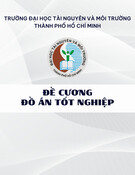
MINISTRY OF EDUCATION
AND TRAINING
VIETNAM ACADEMY OF
SCIENCE AND TECHNOLOGY
GRADUATE UNIVERSITY OF SCIENCE AND
TECHNOLOGY
-----------------------------
TRINH XUAN DUC
RESEARCH AND APPLICATION OF AMMONIA
REMOVAL IN GROUNDWATER ON THE TREATMENT
SYSTEM USING MOVING BED BIOFILM CARRIERS
MAJOR: ENVIRONMENTAL ENGINEERING
CODE: 9 52 03 20
SUMMARY OF THESIS
IN ENVIRONMENTAL ENGINEERING
HA NOI – 2018

The work was completed at: Graduate University of Science and
Technology - Vietnam Academy of Science and Technology.
Facilitator 1: Assoc. Prof. Tran Duc Ha
Facilitator 2: Assoc. Prof . Ngo Quoc Buu
Reviewer 1:
Reviewer 2:
Reviewer 3:
The thesis will be defended before the Examining Board at the
Academy level, meeting at the Graduate University of Science and
Technology - Vietnam Academy of Science and Technology at ...
............................ 2018.
The thesis can be found at:
- Library of the Academy of Science and Technology
- National Library of Vietnam

1
INTRODUCTION
1. THE RESEARCH NECESSITY OF THE THESIS
The demand for clean and hygienic water is always a top
concern and has become a strategy of many countries including
Vietnam. Currently, the living standard in our country is being
improved gradually, awareness of health protection is increasing,
especially in big cities like Hanoi. This is the second most populated
area in the country with a population of about 7 million people in
2014. However, along with the development of many aspects of the
capital, the issue of clean water access has not been met in both
quantity and quality.
The survey results of the Northern Hydrogeological -
Engineering Geological Division showed that the ammonia
concentration in groundwater in Hanoi has exceeded many times
compared to the permitted standards, in which some places are 10-20
times higher.
The biggest concern about ammonia is that the intermediates
such as nitrite and nitrate compounds are formed from ammonia in
the treatment process and use of water for domestic and drinking
purposes under the following mechanism: During the water
treatment process, there always formed naturally Nitrosomonas
bacteria in the filtration tank, which converts part of the ammonia in
groundwater into nitrite intermediates. With sufficient conditions,
under action of a different type of bacteria that is naturally formed in
the filtration tank as Nitrobacter, the nitrite intermediates will be
further transformed into nitrate. While there is insufficient evidence
to assess the extent and direction of the effects of ammonia-based

2
products on the human body, the harm caused by NO2-, NO3- is
well known. NO2-, NO3- are the agents that cause red blood cell
damage in children and may be cancer-causing agents.
One of the few technologies that can meet these
requirements is Moving Bed Biofilm Reactor (MBBR) which uses
biofilm on the carriers moving in water when it is operating. Its
treatment efficiency is only lower than the fluidized bed reactor and
much higher than other techniques. Its operation is much simpler
than the fluidized bed reactor that requires a high automative level.
Most of the materials and equipment of the MBBR
technology are easy to find and manufactured domestically.
Based on the above facts, the topic "Research and
application of ammonia removal in groundwater on the treatment
system using moving bed biofilm carrier" was selected for this
thesis.
2. OBJECTIVES AND CONTENTS OF THE THESIS
2.1. Objectives of Research
- Research on ammonia removal in groundwater in Hanoi
with the concentration of less than 25mg/L (20mgN/L) by
simultaneous Nitrification and Denitrification process in the
equipment using MBBR with porous carriers (DHY) of a high
surface area of about 6,000-8,000 m2/m3, high porosity and light
weight, easily moving in water without addition of substrates.
- Research and design of the treatment equipment using
integrated DHY carriers including MBBR tank and self-cleaning
filter tank for ammonia removal in groundwater in order to ensure
clean water standard for eating and drinking purposes, suitable with

3
the investment ability and operational conditions in Vietnam.
2.2. Contents of Research
(1) Collect data and survey the current status of exploitation
and technological line of water plants in Hanoi area in order to
evaluate groundwater quality, ammonia pollution and influential
factors such as pH, temperature, alkalinity, organic matters,
phosphorus and ammonia treatment efficiency of existing production
lines.
(2) An overview of ammonia treatment methods in the
country and the world, analyze advantages and disadvantages and
raise the existing problems.
(3) An overview of ammonia treatment by microbiological
method to understand the treatment mechanism, various types of
microorganisms, influential factors and kinematic reaction models as
the basis for selecting the pilot models, analyzing and evaluating the
results obtained on the experimental model and field pilot model.
(4) An overview of biofilm and the works using this
technology, evaluating the advantages and disadvantages of each
type of biofilm, each type of work for which to propose moving bed
biofilm carriers to use for design of ammonia removal system in
ground water in Hanoi.
(5) Experimental research on laboratory model: Batch and
continuous experiments are made to determine kinematic parameters
such endogenous degradation factor kp (d-1), biomass efficiency Y (g
SK/g N-NH4+), ammonia semi-saturation indicator Ks (mgN/L),
substrate consumption coefficient k (μ/Y). Assessing the factors that
affect the nitrification process: ammonia input, dissolved oxygen


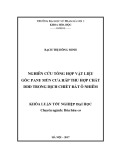
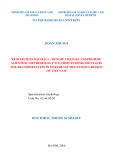
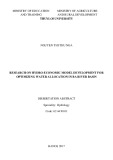
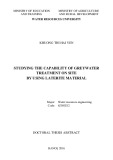

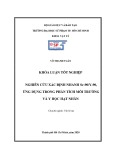


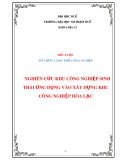

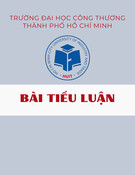
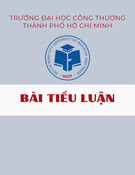
![Ô nhiễm môi trường không khí: Bài tiểu luận [Nổi bật/Chi tiết/Phân tích]](https://cdn.tailieu.vn/images/document/thumbnail/2025/20251011/kimphuong1001/135x160/76241760173495.jpg)

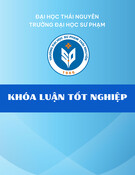





![Ứng dụng kỹ thuật trao đổi ion trong điện phân: Bài tiểu luận [chuẩn nhất]](https://cdn.tailieu.vn/images/document/thumbnail/2025/20250829/sonphamxuan1808/135x160/97341756442892.jpg)
